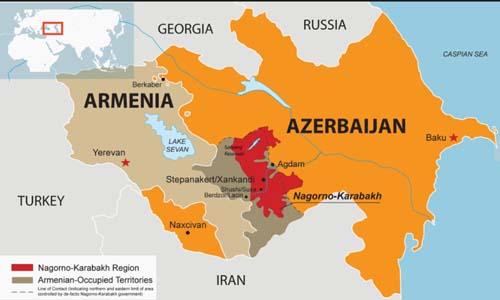
Azeri-Armenian relations take important step forward
Yasar Yakis
Azerbaijan President Ilham Aliyev last week announced that control of the Lachin Corridor between Armenia and Nagorno-Karabakh had been transferred to the Azeri authorities. Because of its strategic importance, this corridor had been the first target of the Armenian forces during the First Nagorno-Karabakh of 1988-94.
This news coincided with a trilateral meeting hosted in Brussels by Charles Michel, the president of the European Council, with the participation of the Azeri and Armenian leaders. There was reserved optimism in both capitals, Baku and Yerevan, about the outcome of the meeting. There is also Russia that does not want to lose its key role in this arena. President Vladimir Putin contacted Armenian Prime Minister Nikol Pashinyan immediately after the Brussels meeting to remain up to date with the developments.
The second war between Azerbaijan and Armenia was ended in November 2020 when Putin brokered a ceasefire. Article 6 of the ceasefire agreement provided that the Republic of Armenia would return to Azerbaijan the 5 km-wide Lachin Corridor by Dec. 1, 2020. This commitment has now been fulfilled, although after a lengthy delay.
Before the 1988-94 war between Azerbaijan and Armenia, Lachin was a district of more than 65,000 inhabitants, but not a single Armenian lived there. Separate from the district of Lachin, the Lachin Corridor is a geographical area that Armenians used to cross from Armenia proper to Nagorno-Karabakh. It was mainly composed of downtown Lachin and two nearby villages, Zabuh and Sus.

When the Azeris were forced to flee in 1988, the area remained deserted for about 20 years. Then, Armenians from Lebanon and Syria were settled there, in violation of the provisions of the Geneva Conventions.
This shortsighted decision now causes problems for the Armenian authorities. The settlers have to move again to a new area either in Nagorno-Karabakh or in Armenia proper. Some of the settlers have burned down the houses they illegally occupied for years. The Armenian authorities had to offer them compensation for agreeing not to do so.
The ceasefire agreement provided that Armenia would return to Azerbaijan the 5 km-wide Lachin Corridor — this commitment has now been fulfilled.
If Putin had not intervened to end the 44-day war that took place between Azerbaijan and Armenia in 2020, the Azeri forces were on their way to seizing Stepanakert, the capital of Nagorno-Karabakh. Pashinyan has admitted that the Armenian defenses had collapsed and there was no other solution but to agree to a ceasefire. Putin stepped in and this deal allowed Russia to send soldiers to Azerbaijan as a peacekeeping force, 30 years after they were withdrawn. The ceasefire agreement provides that Russian peacekeeping forces will remain in Nagorno-Karabakh for five years, a term that will be automatically extended for subsequent five-year terms unless there is an objection. It is not known if Russia will ever be interested in withdrawing its forces from Azerbaijan.
The ceasefire agreement also provided that, within three years, a new route should be built to connect Nagorno-Karabakh and Armenia, with the Russian forces deployed to maintain its security. Construction of this road has already been completed by Azerbaijan one year ahead of time and the Russian peacekeepers are now moving into position. The new road bypasses the areas inhabited by Azeris and follows a route to the east of the Lachin Corridor.
However, an important issue remains: Nagorno-Karabakh and Armenia proper are not adjacent to each other. They are separated by a narrow strip of Azeri territory. Therefore, a border station has to be established at the point where the new road crosses the Armenia-Azerbaijan border. Russian peacekeeping forces will probably do their best to secure the smooth flow of Armenians back and forth. But the Azeri authorities will have to carry out their own checks before or after the Russian checkpoints. Otherwise, they would be relinquishing their sovereign right to manage their own border crossing. So far, no clear information has been made available to explain how this mechanism will function.
There was another important provision in the ceasefire agreement. Article 9 provided that: “The Republic of Armenia shall guarantee the security of transport connections between the western regions of the Republic of Azerbaijan and the Nakhchivan Autonomous Republic in order to arrange unobstructed movement of persons, vehicles and cargo in both directions.” This corridor — known as the Meghri Corridor — is 43 km long and hard bargaining is currently underway between Armenia, Azerbaijan and Iran. All stakeholders have a different concept of how this question should be solved.
One can only hope that the progress achieved in the Lachin Corridor issue opens the way for the solution of other controversial issues between these two neighboring countries.
The writer is a former foreign minister of Turkey and founding member of the ruling AK Party
